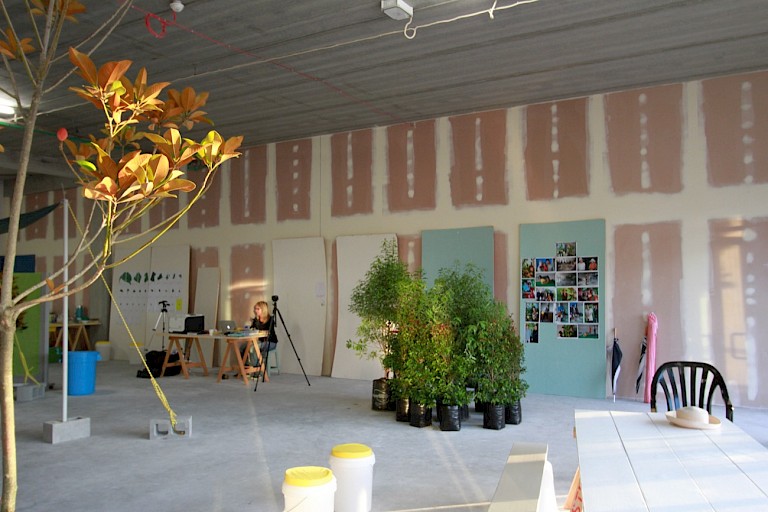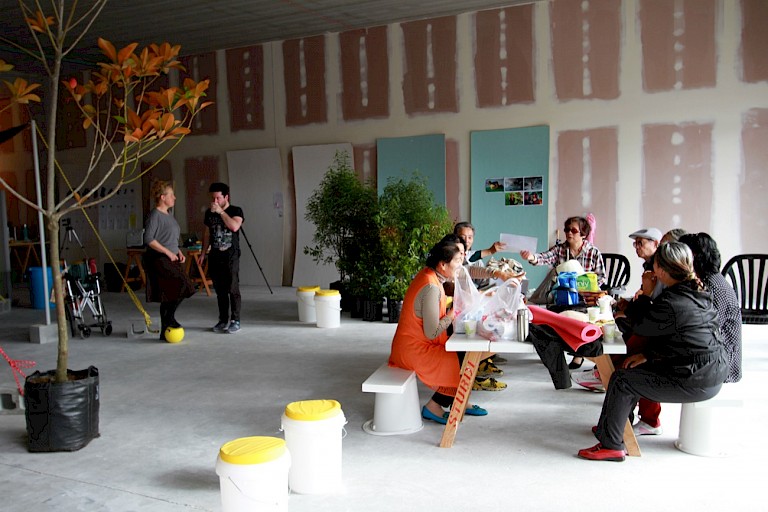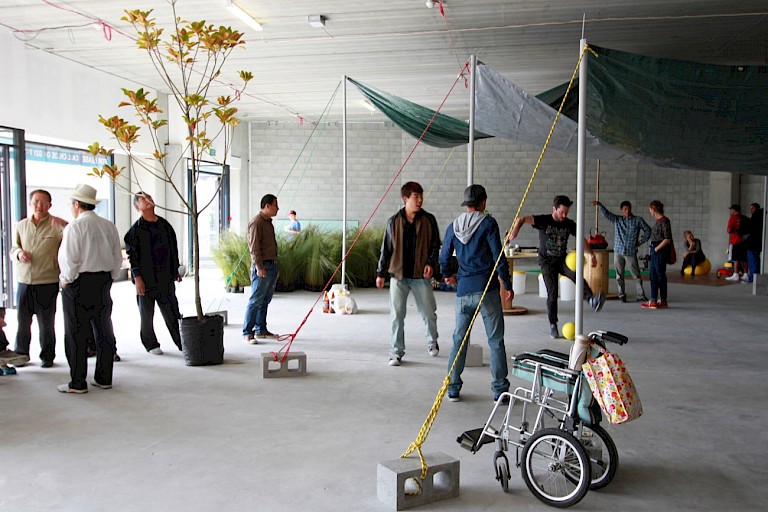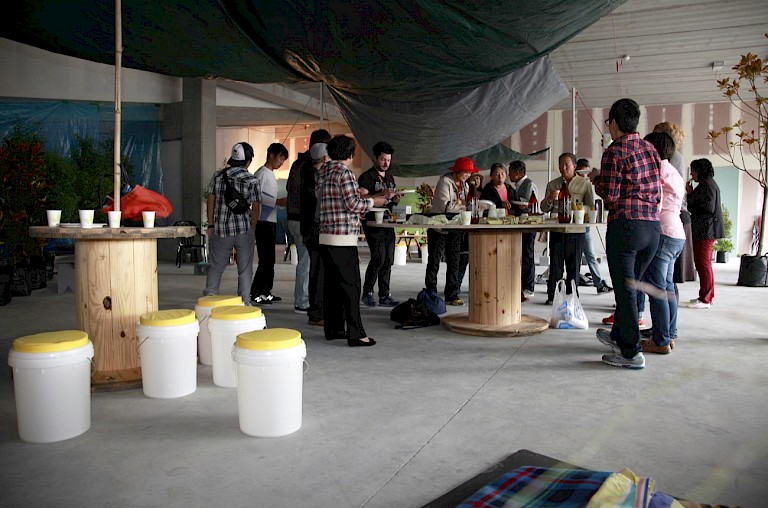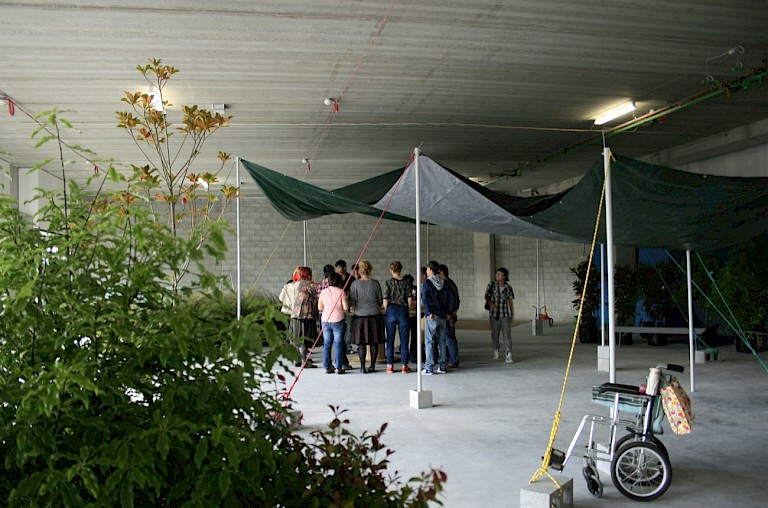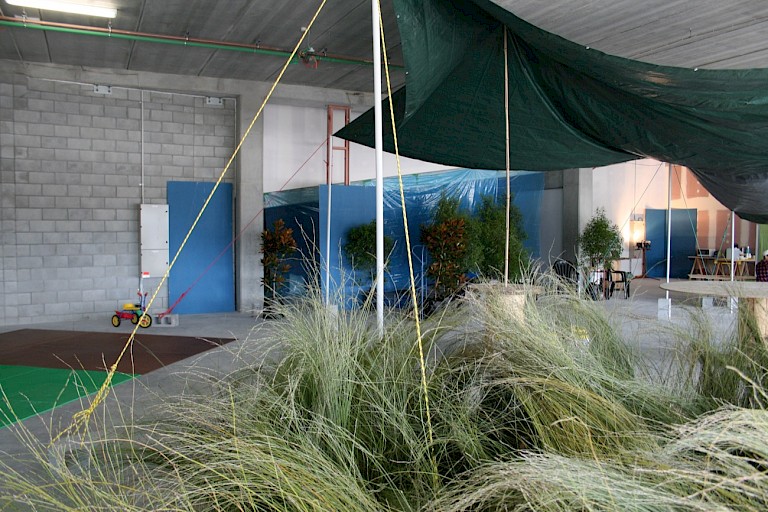



The Suburban Floral Association is the collaborative art enterprise of Monique Redmond and Tanya Eccleston.Established in 2013 in Tāmaki Makaurau Auckland, HOOPLA is a social enterprise producing urban research, place advocacy, community engagement and design.
Tāmaki Makaurau Auckland (Aotearoa New Zealand), like Pōneke Wellington and Ōtautahi Christchurch, exhibits a low-density urban settlement pattern. Planning for Aotearoa’s three largest cities began with the grid, with “ample provision for public space like squares and parks.” However, these public spaces were “sacrificed to commercial imperatives” as the early townships developed, with the consequence that Auckland and Wellington “lacked organised public space to foster civic life” (Schrader, 2014). Meanwhile, residential dwellings privileged the “stand-alone house on an individual section and a cultivated garden” (Schrader, 2014), the fenced-in backyard and “bach” (holiday home) accommodating, to a degree, the social life that might elsewhere and otherwise occur in the public realm.Planners in the late 20th and 21st centuries attempted to address the deficit of civic or public life in these cities by providing civic squares and so-called “pocket parks.” Still, providing such facilities does not necessarily mean that prevailing patterns of public life are transformed overnight. It is in this historical context of urban development that the public artwork Park for a Day and the larger project Make Believe, to which it belongs, acquire their significance. Initiated by Kathy Waghorn (of the collective HOOPLA), Make Believe: Imagining a New Park for New Lynn began in 2012 when the artist/architect learned of plans by Auckland Council to establish a new ‘urban park’ in her neighbourhood (New Lynn, West Auckland). In discussions with the Council, it transpired that a park design had already been commissioned, but the result failed to meet the expectations of the Council’s Community Development Arts and Culture (CDAC) team. Make Believe arose out of a proposal by Waghorn to CDAC.“My proposal was that we generate a series of live, public-realm events on the park site that would make it visible, make it known by residents as a space of potential through producing transformative experiences of it and in it, and, in a transient and culturally diverse neighbourhood, create personal and collective experiences of the place, connecting the past with the future.” (Waghorn, 2017, p. 42)Four projects took place as part of Make Believe between 2012-2014, each generating playful and participatory modes of public engagement in the imagination and design of an urban park in the neighbourhood. Park for a Day was one of these projects, resulting from an invitation to the Suburban Floral Association (a collaboration between artists Monique Redmond and Tanya Eccleston) to develop a work. Waghorn became aware of the Chinese Eco Elders, an already-established neighbourhood group comprising elderly new migrants from China. This group had appropriated a rubble-filled space at the end of a car park left over from nearby development in New Lynn, close to the site for a planned new urban park and transformed this into their own small community garden.Acknowledging their existing interest in botanical spaces and informed by a series of translated conversations, in Park for a Day, SFA worked with the Chinese Eco Elders to develop a day-long installation, a “temporary landscape” inside a vacant shopping development in New Lynn on the 3rd of May, 2014.“Fabricated from stretched tarpaulins, rope, huge cable reels, concrete blocks, timber planks, many potted plants, pieces of furniture and large-scale photographic prints, this Park for a Day responded to a series of conversations with the Elders. The ‘park’ installation was an abstraction, a ‘not-to-scale’ test of possibility where provisional materials were used to make spaces and shelters in which to eat, move, exercise, relax, gather and converse.” (Waghorn, 2017, p. 62).Hosted by SFA and Waghorn and attended by the Chinese Eco Elders and their extended families and friends, interpreters, CDAC staff and volunteers, the event within the installation took the form of convivial conversations around the cooking and sharing of food. SFA describes the makeshift “landscape” created within the vacant building as a “propositional space”, but the project might also be characterised as a form of social sculpture. Instead of ‘consulting’ via pre-formed, language-based methods, CDAC staff were able to join the Chinese Eco Elders in this carefully crafted temporal ‘park’ and together imagine and perform possibilities for the future urban park.
One of the strengths of Park for a Day is its performative engagement with a group that is usually excluded by conventional urban planning and design consultation processes. While the Chinese community is sizeable in New Lynn (the wider “Asian” community makes up 36% of this electorate), this community is not well represented in politics (Chen, 2023). At a local level, this lack of representation translates into the absence of these diverse community voices in consultation processes around the remodelling of the area’s urban form. The skilful combination of installation, props and materials, ritual, food and conversation no doubt explains (at least partially) the success of this propositional mode of “social dreaming” or “speculative design” (Dunne and Raby, 2013). In this, SFA and Waghorn might be considered to extend the legacy of Suzanne Lacy’s “new genre public art,” specifically, the project Immigrants and Survivors (1983), which explored the notion of a women’s community across different (and marginalised) cultures through food, ritual and conversation.“Many conventional design consultation methods are constrained by a discourse framing the ‘already known’. The survey questionnaire for example presumes a pre-conceived range of possibilities: Should we provide space for dogs? Should we include a playground? In Make Believe the potential of the unknown was instead approached through a series of episodic live events curated for the town centre, each allowing for a fleeting and propositional manifestation of this future park to emerge, with each iteration drawing together a different group of constituents.” (Waghorn, 2017, p. 43)Like Park for a Day, the other strands of Make Believe engaged communities and constituencies in collectively imagining a future park and indeed, the future of New Lynn as a neighbourhood and urban social form. In making performative space for the unknown, the Make Believe methodology provides lessons for future urban planning and remodelling processes that chime with the insights from Sendra and Sennett’s (2020) Designing Disorder: Experiments and Disruptions in the City in which they rally against prevailing models of urban planning and development that in their view rigidly over-determine urban form and social life by excluding the unknown and unthought (as well as entire constituencies). By making room for “disorder” in the form of the unknown, Park for a Day facilitated the expanding outwards (rather than turning inwards) of a community group. It is precisely this expanding outward that socially engaged art practices can lend to such processes and that is required of all constituencies if urban planning and design are to result in places that nurture rather than stifle and unite rather than divide and which ultimately provide the conditions for dynamic public or civic life.
